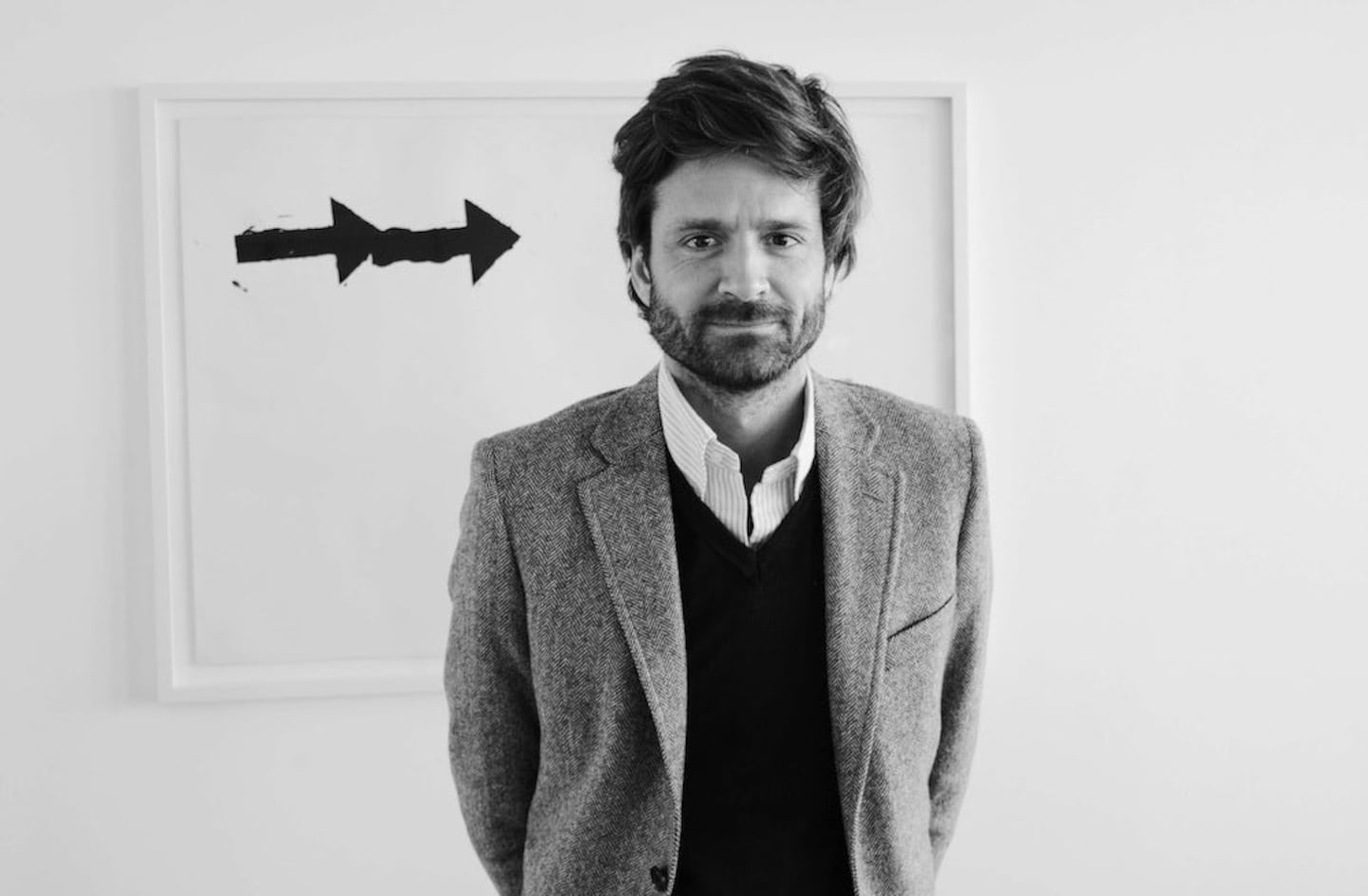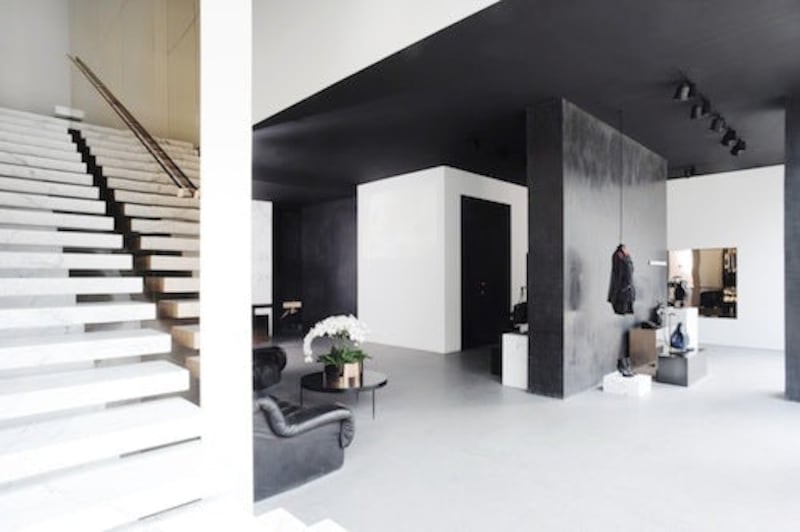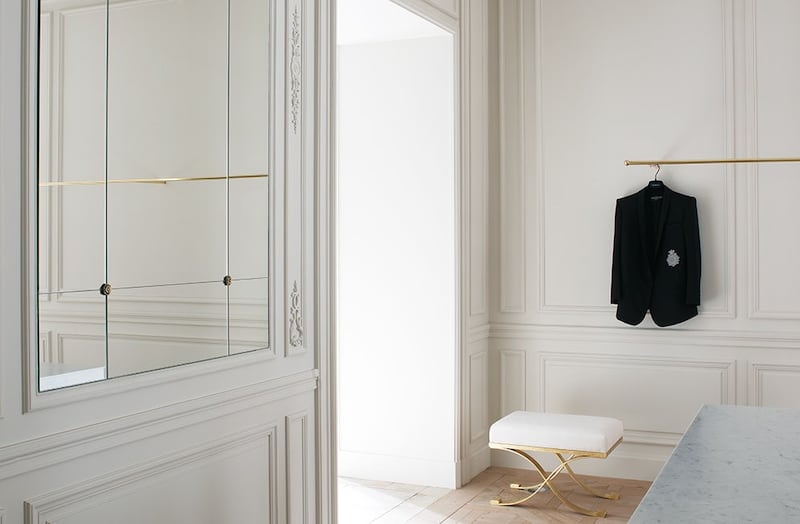
The Business of Fashion
Agenda-setting intelligence, analysis and advice for the global fashion community.

Agenda-setting intelligence, analysis and advice for the global fashion community.

PARIS, France — Joseph Dirand's architectural practice sits on the top floor of a theatre building not far from Montmartre. It's an unusual edifice, strangely nondescript amidst the opulence of Haussmannian Paris, yet somehow haunting, with a lobby and stairwell that wouldn't be out of place in a corporate building in Menlo Park, California, or a Kubrick film. Even Dirand's downstairs neighbours seem out of place: US Airways. One wouldn't expect an airline, let alone this airline.
It is a jarring setting in which to find Dirand, one of the most sought-after architects and interior designers in fashion and the creative mastermind behind the brand-new Givenchy store in Paris, Rick Owens' Mayfair boutique as well as Alexander Wang's Beijing outpost. He has also designed luxury hotels in Mexico and the Monsieur Bleu restaurant at Paris' Palais de Tokyo, which mixes the elegance of early Viennese modernism with electrifying jolts of various provenance: a shade of green here, an unexpected lamp there and exquisite Lalique glass wall panels throughout.

Alexander Wang store in Beijing | Photo: Adrien Dirand
Yet, the unexpected address is perhaps fitting for an architect who has built a reputation for projects that are as radical as they are classic, at once austere and replete with visual information, and whose guiding philosophy for life seems to be to see, consume, and experience it all.
ADVERTISEMENT
"I love to live, I don't sleep a lot," Joseph Dirand told BoF. Dirand, In fact, rarely gets more than 5 hours of sleep a night, and there is something positively vampiric about the Frenchman's appetite for life. "I love to cook, I love to visit and entertain friends, I love to go out, I love to travel, I love to dance — you have to eat life."
To wit, the night before BoF sat down with Dirand, he had been to Titty Twister, a trendy Paris boîte named after a club in a film by Quentin Tarantino — a director Dirand happens to admire — just because he couldn’t miss a set by a visiting DJ he loves. Naturally, Dirand’s voracious curiosity extends to music. He confesses to be a total music junkie, regularly travelling to music festivals with his girlfriend. "I listen to music non-stop. I am always downloading new stuff." Right now, he is listening to a lot of minimalist electro, such as Toronto house duo Art Department.
"What I like about this music is the mechanism of it. It starts with a rhythm, which lasts for about a minute by the end of which your own body is bumping to the beat of this rhythm. And while it's installing that, it is already adding other layers, which you also internalise without noticing it, and it just keeps growing like that. It really has an interaction with your own system, which I love."
The same thing can be said about Dirand's designs, which slowly build on a deceptively spare base vocabulary — consisting of precise lines, sensuous volumes, a monochrome palette, and rich materials — until all of one’s senses are enveloped by a spatial experience that is simultaneously out-of-time and of-the-moment, and which seems to be the only possible solution for the given space. More than an architect, Dirand treats space like a dramaturgist handles narrative.
A visit to the Balmain boutique on Rue Francois 1er for example, considered by some to be the most beautiful fashion store in Paris, unfolds like a carefully written scenario. Housed in the former studio and couture salons of the house’s founder, Dirand's design took in the rich legacy of the place and exploded it with minimal interventions, most notably a warm wooden parquet floor and three mirrored geometric volumes that refract and reinvent the classical proportions of the salon to stunning effect.

Balmain store on Rue François 1er in Paris | Photo: Adrien Dirand
In a way, it seems inevitable that Dirand ended up designing fashion boutiques, as both fashion and architecture run in his blood. While Dirand's father was a respected photographer specialising in interior architecture, his mother was a fashion designer who at one point had been in charge of producing fashion shows in in New York for the house of Cacharel. Thus, at an early age Dirand was exposed to a multitude of aesthetic references. "I grew up with this huge quantity of information," he says.
At the age of 12, a precocious Dirand wrote a 100-page paper for school analysing Le Corbusier's entire body of work. The teacher had only asked for 10 pages. It was an early harbinger of what would become his profession.
ADVERTISEMENT
From 1994 to 1999, Dirand studied at the Paris-Belleville School of Architecture. But even before graduating, he was already designing projects for friends, including a private residence in New Delhi and a store for a designer friend of his mother.
When Dirand founded his own, namesake architecture firm two months out of school (he was 26 years old), he already had clients. But Dirand's breakthrough was a Paris apartment for a wealthy American producer, facing Place de la Concorde. Dirand’s radically minimal residential design earned him critical attention from the fashion and design press, and importantly, more commissions.
It was his work for Balmain under the label’s then creative director Christophe Decarnin, however, that set him on the course to become something of a go-to interior architect for fashion brands desiring a distinctive retail environment.
Dirand remembers asking Decarnin: "What are the movies you like, what is your favourite restaurant?" He also asked him to "send me 20 pictures of things you like. Knowing more about the designer helps me, not just his work for the label, but also his personality, it all informs my design. Decarnin had a lot of references to the 80s, disco and black. But in the end, I had to link that to the past of Balmain, which has to do with the ultra-French golden age of haute couture. So my challenge was: 'How can I create a link between Pierre Balmain and this era of classic French glamour and the world and work of its current designer.'"
The result set a new standard for new luxury retail spaces, many of which soon started to emulate the intimate salon-like feeling of Dirand’s Balmain store.
But it is his process, rather than a signature look, that makes brands seek out Dirand. "Chloé called me to design their new store concept after I had done Rick Owens’ store [in London]. These are brands that have nothing in common! That is when I knew that brands come to me not because they are drawn to my style, but to my way of telling stories."
Of course, after working on a string of high-profile luxury retail concepts, Dirand has developed a special expertise for this type of project, "I have worked with so many different brands, with strengths in different product categories, that by now I have become a bit of an expert in retail. I know exactly how to display product, but I hope I am also reinventing the field a little bit. I don’t think a store is good just because it sells a lot or is beautiful, there’s a lot more to it."
What, then, does Dirand see as his mission when working for a luxury fashion brand?
ADVERTISEMENT
"My job is to tell a story that frames the globality of the brand, almost like a resume of its entire history. And to create a compelling experience for the customer, something that resonates on a deeper level, almost like a movie.”
"When I am working for a brand, I start by trying to understand what my subject is, what is the culture of the house,” Dirand elaborates on his method, “What is Chloé, what is Emilio Pucci, what is Balmain? But it's not just what they are today. The brand is not just its current creative director — that's part of it, but it's much more than that, it's its whole history. Real and imagined factors. When you hear the name of a brand, what flavor, thoughts, images does it evoke?"
Indeed, his way of working, while constant, produces distinctive results for every brand, which may be Dirand’s professional advantage over his peers. The process consists of extensive research — on the Internet and in his vast, ever-growing library — as well as copious amounts of free association. "Visual memory is one of my talents. Say a word, or a brand, and a thousand images come to my mind. It's the same for a brand, a hotel, or a place, like Mexico or New York."
For every project, Dirand compiles hundreds of images in a portfolio, which he then edits down to the 20 strongest visual references. Having presented his idea to the client, Dirand passes on to the rendering stage, which is typically obsessive. “Everything is set in the rendering, so before even starting the work [on site], I know where each painting is going to go, at what height it will hang, all the furniture, lamps and the colour of fabrics are selected. I even know how the books will look on the shelves — that way I control everything,” Dirand boasts.
Despite his unbridled enthusiasm for his profession and total absorption in every project, Dirand’s creative process is not without moments of doubt, terror even. “Each time, few weeks before completing a project, I totally panic.”
“It’s because, at this stage, what you have been working on for so long is there, but it’s also not there. And you know that it will be nice, since everything has been controlled and is being executed according to the rendering.” Dirand’s crippling fear: that the completed project “will not have the magic. That it will just be beautiful, maybe even perfect, but not have that additional tension and indescribable quality that makes something great beyond expectations.”
Unsurprisingly for someone who doesn’t want to miss out on anything life has to offer, Dirand’s routine is nothing if not extreme, a uniquely Gallic version of the work-hard, play-hard ethos of many successful fashion professionals. He wakes up at 8am to be in the office by 10. Then he will work right though around 9pm, often without taking a lunch break. “It’s normal for me to work for 11 hours nonstop and then go straight to join friends at a restaurant."
But does he actually like fashion?
That, actually, would be a little bit of an understatement and he would happily swap genders on account of his passion for clothes. "I would love to be a woman for the simple reason that I love fashion so much. Because I think men have so little choice compared to women when it comes to fashion, and it's hard. I see with my girlfriend the range of shoes, shapes, colours women have, and it's not fair." While he calls it 'effortless,' his personal style is as controlled as everything else in Dirand's life: he only wears Thom Browne shirts, Band of Outsiders blazers, Rick Owens leather jackets, Balmain jeans and Pierre Hardy sneakers — but he owns about 50 of each.
Dirand’s advice for aspiring interior architects comes as no surprise: to be as relentlessly hungry for life and engage in its pleasures as enthusiastically as he does. “Be curious, in the sense of being sensitive to everything — food, cinema, music. Try to expose yourself to things that give you pleasure. Pleasure is essential.”
But it’s also important to “control your ego, especially when you are starting out,” he adds. “When you are a student, it’s easy to forget how little you know. With every project I learn something and realise how ignorant I still am.”
To provide actionable insights and inspiration on how fashion and retail industries can further embed diversity, equity and inclusion in the workplace and business strategies today, BoF Careers co-hosted a panel discussion with The Outsiders Perspective. Now, BoF shares key learnings from the panel.
Discover the most exciting career opportunities now available on BoF Careers — including jobs from Tapestry, Alexander McQueen and Toteme.
A US regulator has banned most uses of the clauses, which started as a way for fashion companies to prevent senior executives from walking off with trade secrets, but have become a standard retention tool.
Check out this week’s new partners and openings on BoF Careers, the global marketplace for fashion talent.